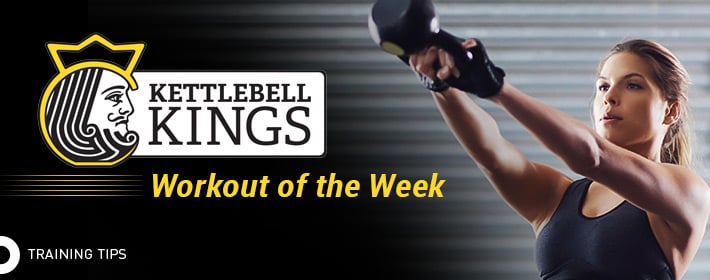Essential Kettlebell Exercises: Kettlebell Swing

The kettlebell swing is truly the unique movement primarily associated with the kettlebell itself which cannot be optimally performed using any other equipment. From top athletes to the new trainee, the kettlebell swing has numerous training benefits which include strength enhancement, power production and endurance.
Kettlebell Swing: Proper Set Up and Patterning
Like the Hardstyle Deadlift, the kettlebell swing is a hinge pattern which primarily utilizes the muscles of the posterior chain (hamstrings and glutes). It’s important to start with a good ground connection which is essential for stability and power production; a flat sole shoe or barefoot is preferred when performing swings.
After establishing a solid ground connection, here are the steps to take to perform a proper Hardstyle 2-Arm Kettlebell Swing:
- Set up in an athletic stance with two hands on the kettlebell which is directly in front of your feet making a triangle position.
- Tip the handle of the bell back towards you and lock your lats into place where the biceps are connected to the ribcage thus creating back tension; think shoulder blades in back pockets.
- To start the backswing; hike the kettlebell through your legs by hinging your hips (not squatting).
- When you feel your hamstrings stretch; squeeze your glutes and drive your feet into the ground to move the kettlebell upward through the legs.
- Make sure the hips and knees always finish (get the hips fully underneath your body and lock your knees); this not only ensures proper technique but also saves your lower back from injury. You want to properly propel the kettlebell upward (not forward) using your hips.
- No leaning back; you want a tall body posture at the top of the movement with the arms extended and the kettlebell parallel to the floor.
- When performing the backswing; wait for the kettlebell to almost hit you before you hinge. The kettlebell should be above the knees and the biceps should connect to your sides just before you hinge. Hinging too early will result in a lack of strength and may cause a sore lower back or an injury over time.
Some other details of the kettlebell swing include:
- Have a good grip on the handle during the swing so the bell does not flop at the top or during the end of the backswing. This excessive movement will make it difficult to keep your body stable.
- A slight elbow bend in the arms is allowed during the swing, however do not actively bend your elbows and pull the bell in towards you to assist the bell up to the top of the swing.
- Traditional hardstyle breathing is one breathing cycle per swing where you inhale through the nose or mouth during the backswing and then a tight exhale (don’t let all your air out) during the upward motion of the swing.
Once you feel comfortable with the 2-arm swing you can start practicing with some of the swing variations that will then help you build the foundation for other kettlebell movements like cleans and snatches.
The Basics of the Kettlebell Swing
- Strengthens: Hamstrings, glutes, core
- Setup: Start with bell slightly in front of shoulders in hinge position. Spine neutral, shoulders just above hip level, set lats & shoulders by "breaking" the bell handle. Feet about hip width apart or slightly wider.
- Key points: Body position in backswing is like a deadlift. At the top of the swing, glutes AND abs should be working (so you are not leaning back and overworking lower back). Let the bell go to its terminal point in backswing before pushing with the hips. Let arms hit the hips before going into backswing. Keep upper body engaged (shoulders packed) the entire time. It's not JUST about going fast; it's about having the correct timing to generate power. Legs locked at the top of the swing. Sharp exhale on the way up to engage core. Slight bend in elbows at the top to let the bell float.
- Common errors: Leaning back at the top of the swing (not engaging abs), bell flipping up towards your butt (either not waiting long enough in bacskwing OR bending at the wrists), hinging too early, rounding back, squatting, arms straight / bell getting away on the upswing
- Applications: Everyone needs glute and hamstring power! This helps you with everything you do: walking, running, jumping, etc. Plus it makes your back strong so prevents injury
Content provided by Kettlebell Kings, Zogics' premier kettlebell provider.
Empower your staff and reassure your community with our FREE downloadable cleaning and disinfecting guides for fitness centers, educational settings, hospitality facilities and more.
Topics from this blog: Product Resources
Back


